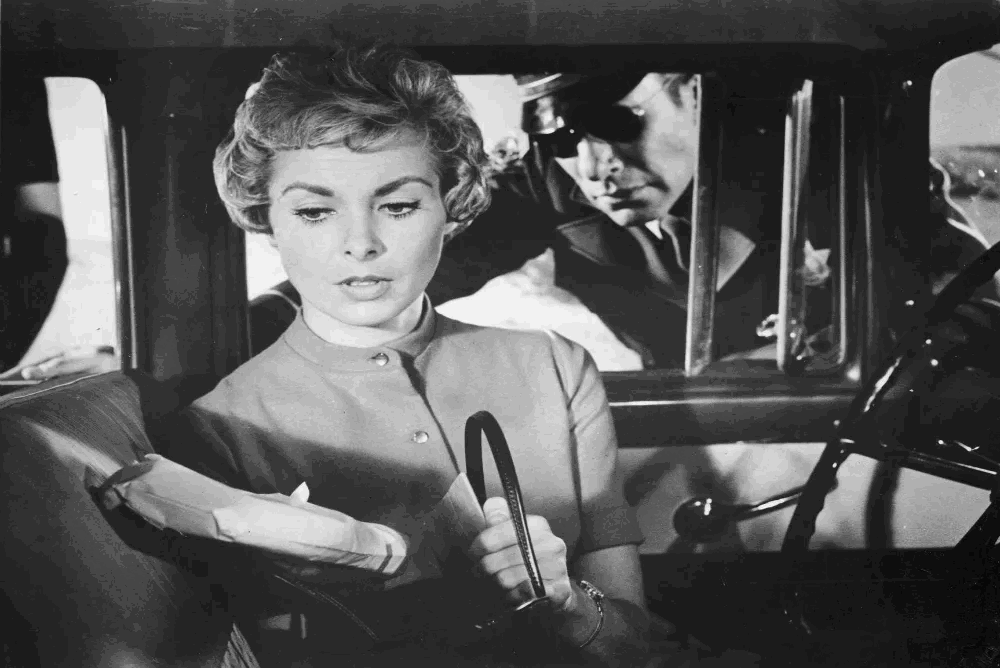Psycho (1960) **SPOILERS**

Having seen stills of horror movies in my brother's cinema magazines, I was keen to sample one, despite being prone to nightmares after watching such as Dr Who. I first saw this at the wholly unsuitable age of 12 and was similarly frightened. I can't possibly have understood the sub-texts in the story, but the murders were terrifying, and the climax in the house ensured I was scared of the dark for ever more.
Watching it again today, I was struck by how much of the tension is generated by the unnerving music and the anticipation that something awful might be about to happen, even though there is little on screen to indicate this.
So, we watch as Marion gets ready to leave Phoenix - in some detail. We stare at her staring at the road ahead as she drives to Fairvale. There is the lengthy business of her wrapping up the money. Later, when the focus switches to Norman, we see gratuitous cleaning up after the first murder.
None of this is necessary in a narrative sense, but coupled with Bernard Herrmann's unsettling soundtrack, it spins out the tension and draws us into the minutiae of the character's thinking. We sympathise with Marion's predicament, and provisionally forgive her stealing $40,000 because Cassidy is so gross, leering over her desk and flashing his wealth; and because we want her to be able to help Sam leave behind his ex-wife and for their love to be fulfilled.
When we watch Norman clear away after his mother's manic mayhem, we sympathise with the downtrodden young man, and we will him to leave Chalet No 1 spotless. He has to get away with it, surely? It's not his fault that his crazy mother has committed such a heinous act that risks her incarceration and his being left alone with his stuffed birds.
Norman's office is his lair. While the camera is drawn to startling angles on the owl and the crow, in the background are classic erotic paintings. Both show a nude woman, one being harassed, perhaps raped, the other showing off her body with pride.
However, we lose sympathy with Norman because of his lack of manliness compared to Sam's; his lack of worldliness next to Arbogast's, and his covering up of his mother's act of murder. So our sympathies switch to Lila, Marion's sister. As before, we get a narratively unnecessary level of detail in her approach of the house and her searching of the two bedrooms. We even see from her point of view, the mirror in which she sees herself, making her and us jump. She is fascinated by the Mother's bedroom, which is suffocating in its decoration, with pictures, ornaments, a dressing table ready for use, and two disembodied hands one laying genteely over the other in mockery of the diabolical occupants of the house.
Could it be that Hitchcock was actually giving us a clue to the mother's real character? Vain, perhaps, but not a tyrant: a sensitive woman entitled to the happiness she sought from a new partner after her husband's death.
In Norman's bedroom, barely advanced from his childhood nursery, an unmade bed, an old, worn teddy bear, a record player with Beethoven's 'Eroica' on the turntable. Why? It's not clear, but among other possibilities are these: Hitchcock might have playfully assumed his audience would see "Erotica", not "Eroica"; or perhaps it's a reference to the Napoleon complex, a common reference to insanity: Beethoven initially dedicated the symphony to Napoleon.) Or Norman must be a closet gay, because "only gays listen to classical music", allegedly. Look at how he simpers in the face of the handsome John gavin.
The one thing we don't see from Lila's point of view is the contents of the book she picks up which has no title on the cover. But we can guess when instead we see the expression on her face.
The horror in this most famous of horror movies lasts for barely a couple of minutes in total: the shower murder, excruciating at any length; the murder of Arbogast only a few seconds, but equally shocking; the dried out, preserved corpse revealed to Lila and the entry of Norman, knife raised at the film's climax.
Every shot, every scene is perfectly constructed, if sometimes artificially so (the three men oddly lined up watching Marion leave the gas station in her new car for example). The music is fabulous. The dialogue is variable, especially in the early exchanges between Marion and Sam and later between Sam and Norman, but the minor characters have a ball with their brief moments: Patricia Hitchcock as Marion's co-worker; the car salesman; the sherriff and his wife ("I helped Norman pick out the dress she was buried in. Periwinkle blue.")
Only the ending seems oddly out of place when the psychiatrist is explaining to us dimbos what was going on in Norman's mind.
Never mind. Even with its flaws, it's brilliant, and shows what horror can do with only a little explicit gore and tons of atmosphere.


